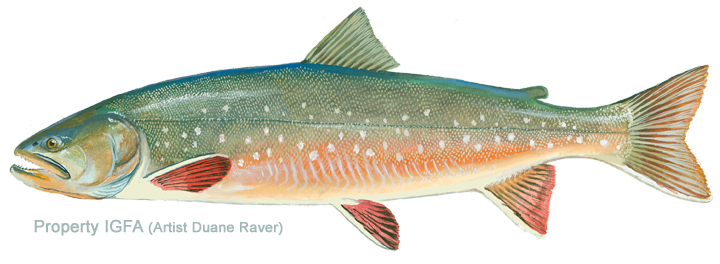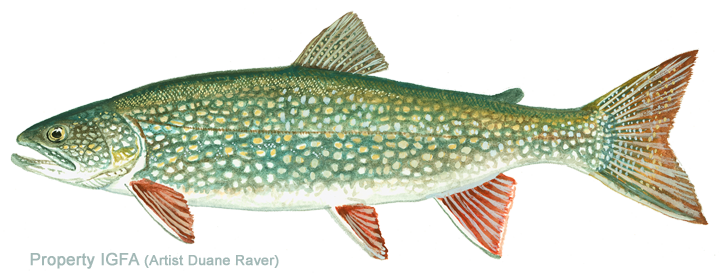Game Fish Identification Reference Guides
Trout, bull
(Salvelinus confluentus)
(Salvelinus confluentus)

(Suckley, 1858); SALMONIDAE FAMILY; also called western brook trout, Rocky Mountain trout, red spotted salmon trout, red spotted char
Endemic to the Pacific northwest, it inhabits most of the major drainages on both sides of the Continental Divide. It seems to prefer large, cold rivers and lakes draining high mountainous areas, and tends to frequent the bottoms of deep pools. It has been recorded in northern California, Oregon, Washington, northern Nevada, Idaho, western Montana, Alberta and British Columbia.
Though described and named by Suckley in 1858, for over a century it was confused with the Dolly Varden (Salvelinus malma) and much of the literature on the Dolly Varden is actually based in part or whole on the bull trout. In 1978, Ted M. Cavender, a fishery scientist, published scientific proof that the bull trout is a separate species [Calif. Fish & Game 64 (3): 139 74]. According to Cavender, separation of the two species is”based primarily on characteristics of the head and cranial skeleton”. He further states that “some of the characters that have been employed for many years in Salvelinus taxonomy, such as numbers of gill rakers and pyloric caeca, will not separate S. malma and S. confluentus. This is one reason why it has not been recognized as a distinct form”.
It resembles the Dolly Varden in external characters, and will probably require laboratory analysis by a scientist familiar with the species to be positively identified. As a rule one can be fairly certain that any char other than the lake trout (S. namaycush) or the brook trout (S. fontinalis), weighing over 12 lb (5.44 kg) and taken in the areas mentioned, will prove to be a bull trout. (See “Salmons, Trouts & Chars”.)
The bull trout and the Dolly Varden are not as highly rated as game fish as most other members of the Salmonidae family, but they do have considerable sporting and food value and are gaining esteem
Endemic to the Pacific northwest, it inhabits most of the major drainages on both sides of the Continental Divide. It seems to prefer large, cold rivers and lakes draining high mountainous areas, and tends to frequent the bottoms of deep pools. It has been recorded in northern California, Oregon, Washington, northern Nevada, Idaho, western Montana, Alberta and British Columbia.
Though described and named by Suckley in 1858, for over a century it was confused with the Dolly Varden (Salvelinus malma) and much of the literature on the Dolly Varden is actually based in part or whole on the bull trout. In 1978, Ted M. Cavender, a fishery scientist, published scientific proof that the bull trout is a separate species [Calif. Fish & Game 64 (3): 139 74]. According to Cavender, separation of the two species is”based primarily on characteristics of the head and cranial skeleton”. He further states that “some of the characters that have been employed for many years in Salvelinus taxonomy, such as numbers of gill rakers and pyloric caeca, will not separate S. malma and S. confluentus. This is one reason why it has not been recognized as a distinct form”.
It resembles the Dolly Varden in external characters, and will probably require laboratory analysis by a scientist familiar with the species to be positively identified. As a rule one can be fairly certain that any char other than the lake trout (S. namaycush) or the brook trout (S. fontinalis), weighing over 12 lb (5.44 kg) and taken in the areas mentioned, will prove to be a bull trout. (See “Salmons, Trouts & Chars”.)
The bull trout and the Dolly Varden are not as highly rated as game fish as most other members of the Salmonidae family, but they do have considerable sporting and food value and are gaining esteem
















